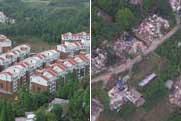China
Ground Application System for Chang´e one to come under world focus
Source: CCTV.com | 11-06-2007 13:42
Special Report: Chang'e I -Journey to the MoonThe first picture of the Moon is expected to be sent to earth later this month, then the Ground Application System of Chang'e One, another key part of China's lunar mission, will come under world focus. Its main function is to realize the mission's scientific objectives by processing the data. China has built two giant receiving stations over the past two years to upgrade its capability to collect signals from deep space.
The National Astronomical Observatory—the headquarters for the Ground Application System of China's lunar probing project -- the Chang'e One, is the key center for the whole project, It sets out the scientific objectives and processes all of the data sent from the moon. And the final research results will also be coming from here.
The center is responsible for data collection and storage from the Chang'e One. It also sends instructions to the pay loads on the satellite to carry out scientific work. All of the data from the satellite will be collected via the two extra-large receiving stations in Miyun and Kunming. After a complicated and delicate procedure, all of the data will be restored into its original form that mirrors the actual objects on the moon. These activities will achieve the scientific objectives of Chang'e One.
Reporter: The scientific objectives of China, Japan, India and Germany are similar?
Zou Yongliao, deputy-commmander of Ground Application System, said, "To get first hand data from any of the planets in outer space, you have to follow four basic scientific objectives. That includes mapping the geographical landscape, surveying resources and studying the internal structure and environment. That's why all these nations have similar plans.
Reporter: What difference is there between China's lunar project and past lunar missions by other countries?
Zou Yongliao: There is certainly some uniqueness in each of the country's scientific objectives. For example, China will for the first time probe into the thickness of the lunar earth with microwaves. That's so we can study the history of efflorescence on the lunar surface and helium-3 resources.
Reporter: Will Chinese scientists share the results with the rest of the world?
Zou Yongliao: Cooperation in exploring outer space, especially the moon and mars, has been a growing trend. Chinese scientists are willing to share our achievements with others for common development.
These computers are the servers and hard disks of the Ground Application System. About 30 terabytes of data will be stored here. The office also holds communication and security facilities.
Zhu Lan, staff of National Astronomical Observatory, said, "All of this equipment is used to catch data received from the two antennas -- in Miyun and Kunming, for the headquarters' later processing."
The Observatory's Chief Scientist for the Ground Application System is Ouyang Ziyuan. He says this system is based on Chinese technology and innovation.
Ouyang Ziyuan said, "China has accumulated rich experience in data collecting and processing for the earth satellites. It has also borrowed some from other nations. But for moon exploration, we have to build a new software system to accomplish our goals."
Data from the moon can only be received for about 10 hours each day. That's because the earth and moon are not always in proper alignment to retrieve data. The satellite will then use these pay loads to achieve their scientific goals. Meanwhile, the ground operation has been undergoing numerous practice sessions. But it is still waiting for the real test.
During the period Chang'e One is in moon orbit, the Ground Application system here will keep recording and retrieving data from the deep reaches of space. The work here will decide the final achievements of the Chang'e mission. The journey of Chang'e One lasts about a year. But for these scientists, studying the data it sends back could last their whole lives.
Editor:Zhang Ning



